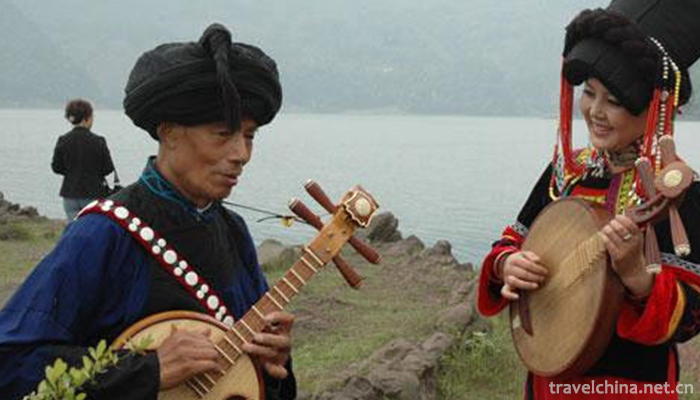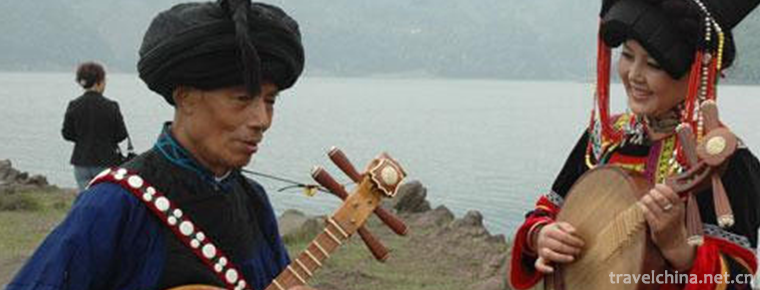Yi Folk Songs
Yi Folk Songs
Yi folk song is an important carrier of Yi culture and one of the most important forms of inheriting Yi culture. It records the history, science, production and life, traditional customs, philosophy, and other rich and colorful Yi culture.
On June 7, 2008, Yi folk songs were listed in the second batch of national intangible cultural heritage list with the approval of the State Council.
historical origin
The Yi people are distributed in Yunnan, Sichuan, Guizhou and Guangxi Zhuang Autonomous Region. The Yi language belongs to the Yi branch of the Tibetan-Burmese language family of the Sino-Tibetan language family, with six dialects. The Yi people have their own characters. They are the earliest syllabic characters in China. Among them, there are more than 1,000 commonly used ones.
There are different kinds of Yi folk songs. Generally speaking, they can be divided into narrative songs, folk songs, love songs, dance songs and nursery songs.
Narrative songs are mostly folk songs of the Yi nationality. They can be used not only for singing about creation and national history, but also for ritual activities such as offering sacrifices to dragons and mountains. Generally speaking, these folk songs have strong narrative, so the general structure is short, the range is not wide, and the melody changes are not too big.
Most folk songs of folk song type have the characteristics of free rhythm, wide range, undulating rhythm and complex structure. Among them, the most representative is the "four tunes" (seafood tune, Shaxi tune, Wushan tune and Four tunes) of the Yi people in the Honghe River, which belong to four kinds of long-structured diverticular folk songs. This kind of folk song with complex structure and long length is also rare in Chinese folk songs. In addition, the singing forms of Yi folk songs are various, including solo, duet, duet, singing with a crowd, or in the same folk song, there are several singing forms at the same time.
In Yi folk songs, there are many expressions of love, while some folk songs are dedicated to the special occasion of social intercourse between men and women. For example, the Yi people in Honghe prefecture have a traditional custom called "eating tobacco", which is a special social activity. On such occasions, couples of young men and women can sing in reply to each other as much as they like. Usually, the main form of duet singing is chorus or collective chorus after a period of duet singing. Folk songs used on such occasions are sung in a low voice with euphemistic melodies. Most of the lyrics are improvised, and there are also a set of traditional lyrics. Most of them are simple, natural and vivid.
Folk singing and dancing activities are an important part of the traditional cultural life of the Yi people. They are usually called "beating songs", "falling feet", "dancing music". They are also called "dancing Lusheng" or "three-step strings" or "miscellaneous strings" because of the different accompaniment instruments. Most of these songs and dances belong to the form of singing and dancing. Some Yi folk songs and dances often change their dances in a certain order. For a long time, they form a group dance according to a certain traditional formula. These dance songs are often singable separately from the dance. Most dance songs have clear rhythm and lively tone.
In Yi folk songs, nursery songs are very rich. In the past, when children had no conditions to go to school, these children's songs became textbooks for children to teach simple life and production knowledge. The content has a certain plot, the language is lively and interesting, and the tune is lively and concise. Singing often takes place in groups, hand in hand, shaking left and right, very naive and complacent.
artistic characteristics
There are various traditional tunes in the Yi people, such as mountain climbing tune, entrance tune, welcome tune, drinking tune, marriage tune, crying tune, etc. Men and women, old and young, will sing a few songs each. Some tunes have fixed words, others don't. They are improvised words. Folk songs are divided into male and female tones, male tones are vigorous and high, female tones are soft and delicate. Local folk songs have their own unique style, such as the famous song "Horse Run faster" and "Guests from afar Please Stay", which are extracted from the folk tunes of the Yi nationality.
Representative Works
Ashima
There is a famous narrative song "Ashima" written by the Sani people of the Yi nationality. Through the struggle between Ashima and Ahai and the Rebubala family, the representative of the feudal forces, it eulogizes the spirit of labor, courage, freedom and resistance, and embodies the strong will of the people of Sani to oppose feudal oppression and the good wish of pursuing freedom and happiness. The people of Sani call "Ashima" the song of our nation. Ashima is a smart, beautiful and industrious girl of Sani nationality, and is the best of tens of millions of Sani girls.
Inheritance Significance
In the Yi people, there are important performances of singing and dancing every year, which are the characteristics of the Yi people. When men and women express their feelings to each other, they will dance Yi dance music around the fire.


-
1.Baisha Lake Scenic Area
Baishahu Lake is one of the important scenic spots in Qianli Gallery in Altay, Xinjiang. It is 100 kilometers from Habahe County, 260 kilometers from Altay Airport, 150 kilometers from Kanas Airport
Time 2018-12-12 -
2.Jiayuguan cultural relics scenic spot
Jiayuguan: World Cultural Heritage, National AAAAA Tourist Scenic Spot, National Key Cultural Relics Protection Unit, National Patriotic Education Demonstration Base.
Time 2018-12-12 -
3.Hailing Island Dajiao Bay Sea Silk Road Tourist Area Yangjiang City
Dajiaowan Scenic Area of Hailing Island in Yangjiang is located in Zhapo Town of Hailing Island, Yangjiang City, Guangdong Province.
Time 2019-01-13 -
4.suyukou national forest park
Suyukou National Forest Park is located in Helan Mountain National Nature Reserve, 50 kilometers northwest of Yinchuan City, capital of Ningxia. It is a national 4A-level tourist attraction.
Time 2019-02-13 -
5.Slab headed qu
Nanyang Bantou music is a unique traditional string music. Music and the Central Plains drum tunes (major tunes) with a long history complement each other. They are preludes played in solo and ensembl
Time 2019-04-03 -
6.Huang Di memorial ceremony
Yellow Emperor's sacrificial ceremony is a kind of sacrificial music and dance to celebrate Xuanyuan Huangdi's pioneering achievements in Chinese civilization. The theme of
Time 2019-05-04 -
7.Shaheteng Array
The rattan array is the only ancient combat technology in northern China. It has gone through hundreds of years since Ming Dynasty. Today, it only exists in Shilipu Village, Shahe City, Hebei Province
Time 2019-06-12 -
8.Butter Flowers in Tar Temple
Butter flower originated from Benjiao religion in Tibet. It is a small decal on the food supply. According to traditional Indian Buddhist customs, the tributes offered to Buddhas and Bodhisattvas are
Time 2019-06-17 -
9.Production Techniques of Wufangzhai Zongzi
The traditional production techniques of Wufangzhai zongzi are mainly divided into 36 processes, such as material selection, rice dipping, leaf boiling, stuffing, shelling, wrapping, thread binding an
Time 2019-06-29 -
10.Kangding yak meat
There are many wild medicines such as Fritillaria, Cordyceps and so on growing in these areas over 3500 meters. Yaks often eat these herbs, and their meat is incomparably delicious. After being killed, they can be roasted in brown sauce, stewed or dried in the cold
Time 2020-12-06 -
11.Geographical environment of Guangyuan
Guangyuan City is located in the north of Sichuan Province. Its geographical coordinates are 31 ° 31 ′ n to 32 ° 56 ′ N and 104 ° 36 ′ e to 106 ° 45 ′ E. in the north, it borders Wudu County, Wen County, Ningqiang County and Nanzheng County of Shaanxi
Time 2020-12-15 -
12.Leshan culture
By the end of 2018, Leshan has 12 mass cultural centers, 12 public libraries, 10 museums, 218 cultural stations and 29 City cinemas. There are 12 free libraries, 12 cultural centers, 218 township cultural stations and 3 museums. 2003 rural libraries and 276
Time 2020-12-17